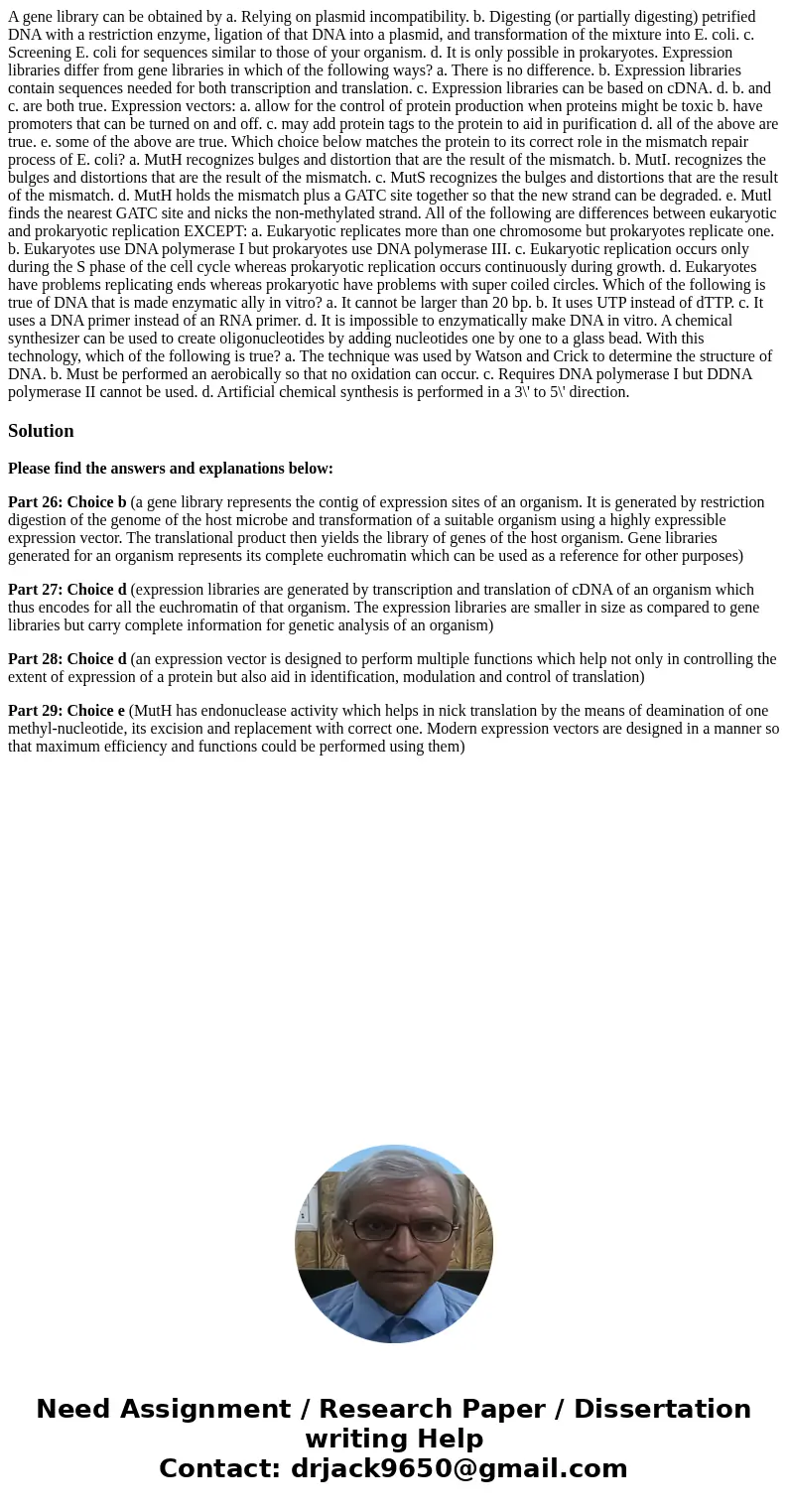A gene library can be obtained by a. Relying on plasmid incompatibility. b. Digesting (or partially digesting) petrified DNA with a restriction enzyme, ligation of that DNA into a plasmid, and transformation of the mixture into E. coli. c. Screening E. coli for sequences similar to those of your organism. d. It is only possible in prokaryotes. Expression libraries differ from gene libraries in which of the following ways? a. There is no difference. b. Expression libraries contain sequences needed for both transcription and translation. c. Expression libraries can be based on cDNA. d. b. and c. are both true. Expression vectors: a. allow for the control of protein production when proteins might be toxic b. have promoters that can be turned on and off. c. may add protein tags to the protein to aid in purification d. all of the above are true. e. some of the above are true. Which choice below matches the protein to its correct role in the mismatch repair process of E. coli? a. MutH recognizes bulges and distortion that are the result of the mismatch. b. MutI. recognizes the bulges and distortions that are the result of the mismatch. c. MutS recognizes the bulges and distortions that are the result of the mismatch. d. MutH holds the mismatch plus a GATC site together so that the new strand can be degraded. e. Mutl finds the nearest GATC site and nicks the non-methylated strand. All of the following are differences between eukaryotic and prokaryotic replication EXCEPT: a. Eukaryotic replicates more than one chromosome but prokaryotes replicate one. b. Eukaryotes use DNA polymerase I but prokaryotes use DNA polymerase III. c. Eukaryotic replication occurs only during the S phase of the cell cycle whereas prokaryotic replication occurs continuously during growth. d. Eukaryotes have problems replicating ends whereas prokaryotic have problems with super coiled circles. Which of the following is true of DNA that is made enzymatic ally in vitro? a. It cannot be larger than 20 bp. b. It uses UTP instead of dTTP. c. It uses a DNA primer instead of an RNA primer. d. It is impossible to enzymatically make DNA in vitro. A chemical synthesizer can be used to create oligonucleotides by adding nucleotides one by one to a glass bead. With this technology, which of the following is true? a. The technique was used by Watson and Crick to determine the structure of DNA. b. Must be performed an aerobically so that no oxidation can occur. c. Requires DNA polymerase I but DDNA polymerase II cannot be used. d. Artificial chemical synthesis is performed in a 3\' to 5\' direction.
Please find the answers and explanations below:
Part 26: Choice b (a gene library represents the contig of expression sites of an organism. It is generated by restriction digestion of the genome of the host microbe and transformation of a suitable organism using a highly expressible expression vector. The translational product then yields the library of genes of the host organism. Gene libraries generated for an organism represents its complete euchromatin which can be used as a reference for other purposes)
Part 27: Choice d (expression libraries are generated by transcription and translation of cDNA of an organism which thus encodes for all the euchromatin of that organism. The expression libraries are smaller in size as compared to gene libraries but carry complete information for genetic analysis of an organism)
Part 28: Choice d (an expression vector is designed to perform multiple functions which help not only in controlling the extent of expression of a protein but also aid in identification, modulation and control of translation)
Part 29: Choice e (MutH has endonuclease activity which helps in nick translation by the means of deamination of one methyl-nucleotide, its excision and replacement with correct one. Modern expression vectors are designed in a manner so that maximum efficiency and functions could be performed using them)

 Homework Sourse
Homework Sourse